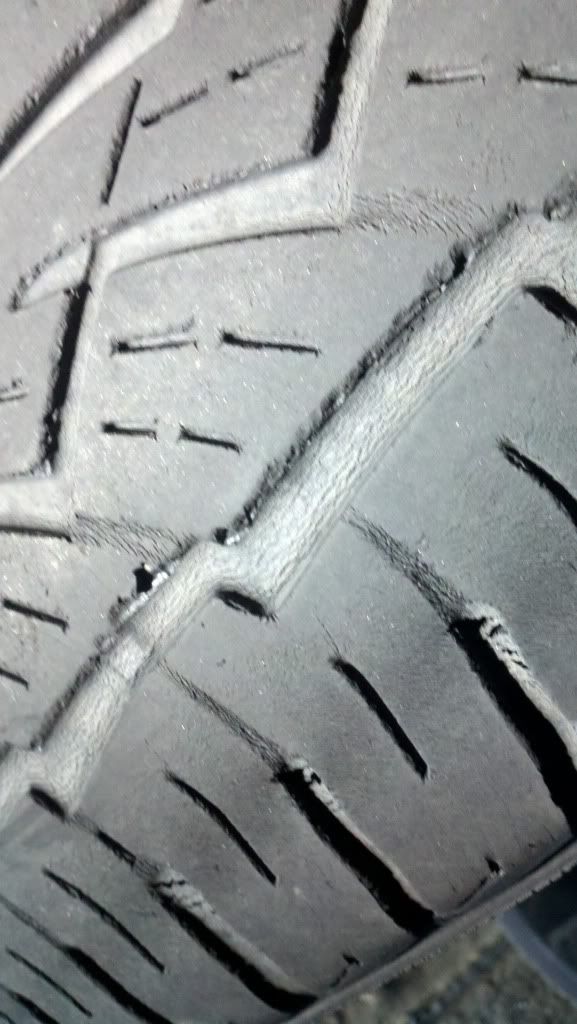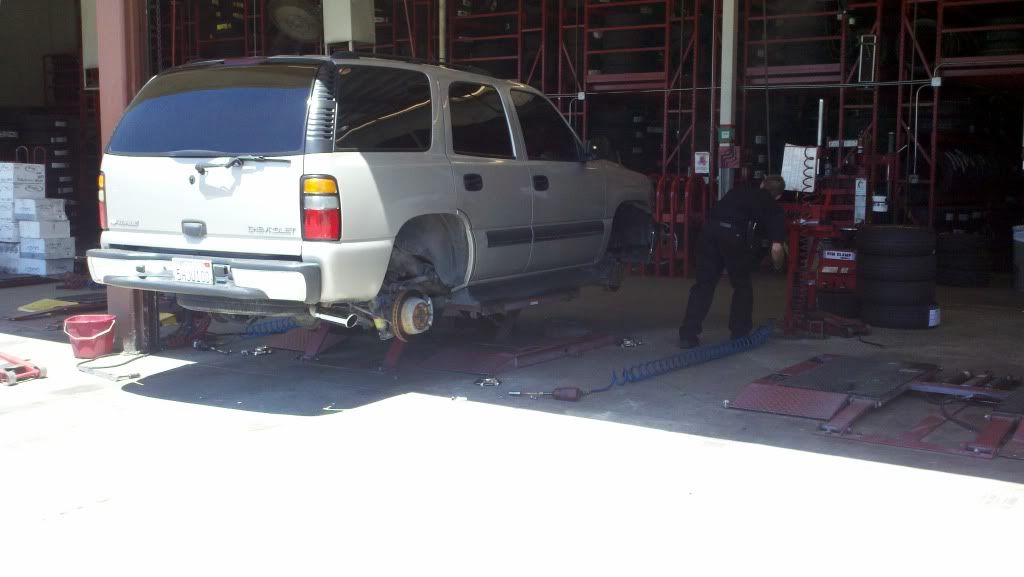Yeah, sounds/looks like a defect. It reminds me of how the sidewall will bulge with a broken belt in the tire. But i'm not sure. Definitely not safe...
This tire is from my 04 Tahoe. Size is 275/55/20 Falken Ziex
they have a max pressure of 50 and I keep them at 40. It pulls hard to the opposite side this tire is on if it's in the front. So it was in drivers side and it would pull to pass. So for this reason I took it to the alignment shop, alignment was good. about 0.01 off on toe. He check the suspension and all the bushings and shocks are good. Then he saw this tire and move to the back, he said since the rear axle is completely straight it wouldnt pull anymore, but no good to keep for long. He told me it could just be bad construction of the tire. They have 50,000 mile warranty they have been driven for less than 30. Would this be a defect. It also has alot of cracks. And so do the rest of the tires.

Yeah, sounds/looks like a defect. It reminds me of how the sidewall will bulge with a broken belt in the tire. But i'm not sure. Definitely not safe...
-Andrew
40 seems a bit high, my Montero I think ran on 36 psi and that truck was 4400lbs so I dont think your stock tire pressure is 40. That looks like your tires are over inflated, which is user error which means most likely they wont honor your warranty. Get out the owners manual and check your tire pressure. The recommendation I believe on an 06 Z71 is 30 psi so yours should be in the ball park of that. Remember you take tire pressure when the tires are cold and when you drive them they heat up. So at 40psi and you drive the truck say for 60 miles at 60mph you will gain usually 3-6 Psi so you're approaching max psi the tire can handle which is what causes cracks.










The belt shifted. That generally happens from what they call an impact break. You hit a pothole or something with enough force to partially separate the steel belts in the tire. Very doubtful it's a defect since it would have shown up much earlier than 30k miles. It's a pretty common occurance when you go to a much lower profile tire. Especuially if the roads around you are anything like jersey roads. More potholes than pavement.
MECP First Class Certi-fried installer.
For the right price, nothing is impossible.
Yup not safe at all, gonna stay away from it until I take it to Americas Tire where I know the General Mgr, hopefully he finds a loophole in the policy and gets me in.
Well this isn't the stock wheel, it is the stock size from newer ones with stock 20's,my little sticker reads 265/70/16, and when I tested psi it was warm since I had just returned from the grocery store. So pressure must be mid 30's on cold. Also over inflation cause this sort of bulge in he middle, if anything it is under inflated, but it keeps me thinking because it looks like it's cause by pressure. I'm gonna take it in this weekend and have it checked out.
I hardly drive this truck, gas prices mostly. Usually i'm in the G. I bought this from my dad last year and he babied this thing, 15 miles to and from work on smooth roads and underground parking. And since I've had it I have never impacted anything. Profile isn't that low its got good meat. at least 5 inches of sidewall.
u have to go by the psi thats on the tire not in the user manual, i mean u can butt its what the tire calls for psi
^^^Max on them is 50. I do go by that, I think it's a defect.
You don't inflate your tires based on the pressure listed on the tire itself. You go by what the vehicle's owners manual and information placard. Running tires overinflated can produce future tire issues (tread de-lamination/separation).
That is called: Tread De-lamination.
The belt package has separated internally. This can come from a few things:
Age
Improper Air Pressure
Impact
Wear
In most respects it is a not uncommon occurrence as the tire ages. Usually 1 of 4 exhibit mild de-lamination issues. The consideration that must be made is that even by only 30,000 miles the tire has quite literally rotated 20,000,000+ times.
It certainly is a defect, but simply a result of use. I would still recommend that you talk to your place of purchase, the manufacture (Falken), should still provide some concession as a courtesy.
^^^^The man has spoken. The tires have seen 3 very hot summers of trips to vegas, SD, L.A. so I guess Age and wear are a factor. 3 yrs life and 30k miles I guess is not bad compared to the low pros on the G.
I will update you guys on the result.
-Greg
"I smashed up the grey one, bought me a red;
Every time we hit the parking lot we turn heads!"
-Pimp C, "International Players Anthem"
^^^Cool deal…I think if they honor me a swap I will upgrade to the Eagle LS-2's from goodyear. There aren't many choices in this size. At americas anyway.
As an update, the Manager at Americas Tire said it was because the tire got dryspots inside for lack of movement, so it expanded when it got driven and stayed that way. He classified it as a defect and prorated the tires @ 50% even though it was 30. In the end he upgraded me to 4 new GoodYear Eagle LS-2's with their certificate guarantee for $560 mounted balance and out the door. Cant argue with that. Here she is as I type.

Not bad...bully for you!
I really hope you have read my signature, because if you haven't, this is the reason I give out neg rep.
The pressure on the tire is the max pressure the tire can hold safely, at operating temperature, at max load, at... you know what? Doesn't matter. Wrong information is wrong.
Totally agree.
And to reiterate, put your tires at the pressure that is either located in your owner's manual, or on the door label near the driver's door.
If you post stupid and incorrect information, you will get red nuggets.
QFT. It does not matter on the tires and really the size has little to do in effecting the recommended tire pressure either. Check your tire pressure at least once a month and have fronts and backs at the factory pressures. Your tires will wear more evenly, your gas mileage will be better, your handling will be better as you have a better contact patch, and you dont chew tires.
Not to argue, but tire size and vehicle application do absolutely affect recommended tire pressures. The best course of action is to check manufacturer tire inflation tables. I bet you would be surprised to find out most folks air pressures could use minor increases simply from running larger tires and wheels.
Bookmarks